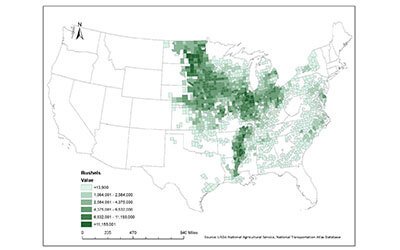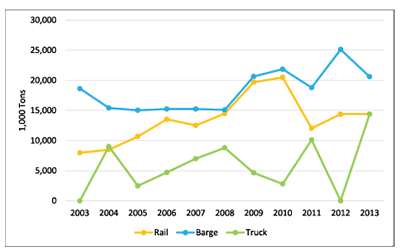CAIT project no.: USDA-RU8861
Fiscal Year: 2016/2017
Status: Final
Principal investigator(s): Yun Bai, Ph.D. (Rutgers)
Performing organization(s): Rutgers CAIT
Coauthor(s):
In cooperation with: Moffat & Nichol
Partner project manager: Walter Kemmsies, Ph.D.
Supported by: United States Department of Agriculture, Agricultural Marketing Service
UTC, grant, or agreement no.: 15-TMXXX-NJ-0008
The supply chain of soybeans is complex, encompassing multiple production sites and multiple modes of transportation. As a result, multiple factors affect the supply chain including weather, seasonality, price, equipment availability, congestion, modal delay, cargo ownership, and requirements pertaining to sustainability or product quality (Clott et al., 2014).
The United States is a leading producer and a major exporter of soybeans. Although most soybean exports are shipped in bulk, shipment by intermodal containers is increasing in popularity. Container transportation currently represents a relatively small share of total U.S. soybean transport but is emerging as a growing niche market that is attracting interest from government and industry sectors (Clott et al., 2015).
It is of keen interest for the United States soybean exporters to identify optimal pathways and to assess the impacts of any existing or emerging changes in the freight industry (e.g., ocean liner vessel sharing agreements) on soybean exports and transportation. Understanding transportation cost is a stepping-stone toward making optimal decisions to further the improvement of the United States’ economic competitiveness in exporting soybeans. However, doing so poses immense challenges. For instance, the international movement of containerized soybeans is operated by multiple modes of transport (truck, rail, barge, containership), each of which has its own unique cost structure and estimation method. Furthermore, there is more than one possible route from almost every origin point in the U.S. to every destination point in a foreign nation.
In order to maintain the competitiveness of the United States in containerized soybean exportation, the USDA funded Rutgers University to study freight cost by modeling the total cost across multiple modes of transportation for soybean exports from the United States.
This study departed from past efforts, which largely focus on soybean bulk transportation, by uniquely targeting the emerging container transportation market for agricultural exports. Built upon an integrated analysis of transportation-mode-specific cost structures and up-to-date data, the study results provide a step-by-step, practice-ready calculation tool by which analysts may estimate the transportation cost from the origin of production to the destination port for soybean container exports. The analysis framework also includes a network optimization model to compute optimal freight flow assignment, route choice and intermodal trans-shipment in order to strategically minimize the total transportation cost nation-wide.
The study results can be further used to evaluate the transportation cost, performance, and bottlenecks of other agricultural products, thereby aiding in prioritizing future investments that enhance the economic competitiveness of the United States agricultural industry.




